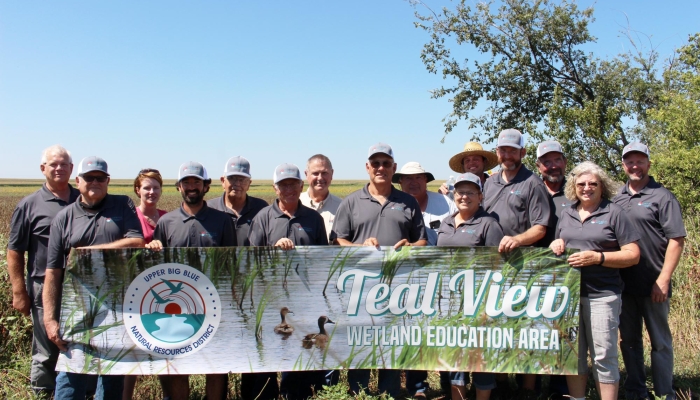Water quality tour displays district projects, challenges
How is water quality being protected and what can be done to improve it in our district? These questions were explored during the annual board of directors tour hosted by the Upper Big Blue Natural Resources District on Friday, August 27. The tour featured six sites in Hamilton and York counties where directors met with experts and saw first-hand what NRD staff and partners are doing to safeguard water quality in the district.
The first stop on the tour was Recharge Lake at Bruce L. Anderson Recreation Area in York. Board members met with Matthew Perrion, a fisheries biologist with Nebraska Game and Parks, who presented information about the deteriorating health of the fishery at Recharge. Water quality in the lake is poor as sediment from surrounding farmland pours into the lake during rain events. A fishing survey conducted by Nebraska Game and Parks in May found poor water visibility throughout the lake, which is a detriment to fish populations, as fish hunt for prey by sight. The murky water means that sunlight can’t penetrate the lake to enable aquatic vegetation to flourish, which is also tied to the decrease in fishery health. The recent report on the lake found no bass and a low number of carp and bullheads, all in poor condition.
Matthew Perrion, fisheries biologist with Nebraska Game and Parks Commission, meets with the board of directors at Recharge Lake
Perrion had some suggestions for the board members on how the fishery could be improved, including digging out the sediment dam on the north end of the lake and designing a wetland area with early successional vegetation to provide better filtration for water entering the lake. Perrion was enthusiastic about a recent board decision to provide incentive payments to producers whose fields drain into Recharge Lake (and other targeted areas) for additional conservation efforts to reduce erosion. Cover crops, buffer strips, and other land treatment practices would prevent sediment from entering waterbodies by holding soil in place on the fields. Perrion suggested that improving the lands around the lake is an important first step before additional funds are spent on restoring the lake.
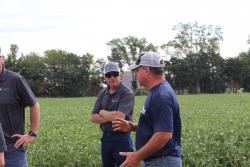 The next stop was Midwest Research Inc, a research farm a few miles from Recharge Lake. Owner Jess Spotanski demonstrated an agricultural drone that can be used to plant cover crops and buffer strips in places that are hard to reach by other methods. Spotanski flew the drone over a field of soybeans, spreading a cover crop mixture a few feet above the plants waving in the wind created by the drone’s eight powerful propellers. The drone can be programed to drop seed with a high degree of precision in a specific pattern or location. The day before the tour, Spotanski and his drone operator used the same piece of equipment to seed a grassed waterway project on a washed-out channel in a field near Recharge Lake. If this planting is successful, the NRD may employ this technology in other locations as it is a simple way to reduce erosion and protect surface water from contamination.
The next stop was Midwest Research Inc, a research farm a few miles from Recharge Lake. Owner Jess Spotanski demonstrated an agricultural drone that can be used to plant cover crops and buffer strips in places that are hard to reach by other methods. Spotanski flew the drone over a field of soybeans, spreading a cover crop mixture a few feet above the plants waving in the wind created by the drone’s eight powerful propellers. The drone can be programed to drop seed with a high degree of precision in a specific pattern or location. The day before the tour, Spotanski and his drone operator used the same piece of equipment to seed a grassed waterway project on a washed-out channel in a field near Recharge Lake. If this planting is successful, the NRD may employ this technology in other locations as it is a simple way to reduce erosion and protect surface water from contamination.
The tour continued with a visit to Pioneer Trails Recreation Area near Aurora. There, board members met with Brad Eifert, another fisheries biologist with Nebraska Game and Parks, who gave a report on the health of the fishery at that site. While not an ideal fishing spot due to increased sediment, the water quality in general is better for fish habitat than Recharge Lake. Eifert reiterated the need for conservation practices in the farmland surrounding the lake to improve water quality; however, the most recent fishing report from Pioneer Trails suggests that there are a decent number of largemouth bass and bluegill thriving in the reservoir, in addition to channel catfish and crappie.
While at Pioneer Trails Recreation Area, the board members also met with Nelson Winkel, a soil health specialist with The Nature Conservancy. Winkle gave a report on the interseeder cover crop trials that the Upper Big Blue NRD, The Nature Conservancy, and Nebraska Extension have partnered to conduct. The project began in 2020 and will continue through 2022. It includes planting a cover crop mix between rows of corn at the V4 to V6 stage of development at 11 test sites across the district. The interseeder planter was on display at the recreation area so that board members could see the equipment up close and talk to Winkle about how it is employed.
The tour continued with stops in Hampton, first at a monitoring well site south of town, where NRD staff demonstrated how wells are sampled. Water from monitoring wells across the district is sampled several times throughout the year to determine the amount of nitrogen and other contaminants present and to look at trends in water quality over time. The wells vary in depth, allowing for data collection from shallow, medium, and deep well sites to capture a more accurate picture of the health of the district’s groundwater. The Upper Big Blue NRD has been tracking this data consistently since 1997 to look at non-point source contamination in the groundwater supply.
The second Hampton stop was at the NRD’s newest recreation area site, Teal View Wetland Education Area. While the location is still largely undeveloped, the board was able to see the site and get a better understanding of how it will be improved in the coming months, including with infrastructure to graze cattle. Cattle will be used as a management tool to maintain the health of the wetland in the future. The location will be a great spot for hunting and other recreation, as well as a place for students to learn more about the importance of wetlands in Nebraska’s landscape.
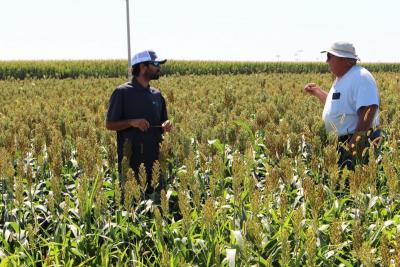 The final destination on the tour was to the soil health demonstration fields managed by the Upper Big Blue NRD on the City of York’s wellfield. The board members heard a presentation from Dan Leininger, water conservationist with the NRD, who oversees Project GROW (Growing Rotational Crops on Wellfield). Now in the fourth year of the project, Leininger and cooperating producer Scott Gonnerman, are experimenting new crops, including alfalfa and milo. In addition to diverse crop rotations, Project GROW also enhances the soil health on these fields with livestock grazing, no-till, and cover crops. These practices increase the microbial activity of the soil as well as its water holding capacity, so that it can provide maximum fertility naturally, without a reliance on synthetic fertilizer and other inputs that would potentially contaminate the water in the wellfield. This wellfield provides drinking water for the more than 8,000 people who reside in York, so maintaining quality above this source is important for the health of York’s citizens. Project GROW is intended to be a program that could be reproduced at public wellfield sites across the district.
The final destination on the tour was to the soil health demonstration fields managed by the Upper Big Blue NRD on the City of York’s wellfield. The board members heard a presentation from Dan Leininger, water conservationist with the NRD, who oversees Project GROW (Growing Rotational Crops on Wellfield). Now in the fourth year of the project, Leininger and cooperating producer Scott Gonnerman, are experimenting new crops, including alfalfa and milo. In addition to diverse crop rotations, Project GROW also enhances the soil health on these fields with livestock grazing, no-till, and cover crops. These practices increase the microbial activity of the soil as well as its water holding capacity, so that it can provide maximum fertility naturally, without a reliance on synthetic fertilizer and other inputs that would potentially contaminate the water in the wellfield. This wellfield provides drinking water for the more than 8,000 people who reside in York, so maintaining quality above this source is important for the health of York’s citizens. Project GROW is intended to be a program that could be reproduced at public wellfield sites across the district.
 “It’s really important for directors to see the projects and programs in our district first-hand so we can make better decisions when these things come up for discussion,” said Lynn Yates, board chairperson, who attended the tour. “If you can see things yourself, it’s easier to understand. I wish all directors would go on these tours because there is so much to see in the district.” Yates appreciated the expert input provided by the fisheries biologists. “I learned so much from the two from Nebraska Game and Parks. It was helpful to learn more about water quality in our reservoirs and what we can do to improve it.”
“It’s really important for directors to see the projects and programs in our district first-hand so we can make better decisions when these things come up for discussion,” said Lynn Yates, board chairperson, who attended the tour. “If you can see things yourself, it’s easier to understand. I wish all directors would go on these tours because there is so much to see in the district.” Yates appreciated the expert input provided by the fisheries biologists. “I learned so much from the two from Nebraska Game and Parks. It was helpful to learn more about water quality in our reservoirs and what we can do to improve it.”
The first stop on the tour was Recharge Lake at Bruce L. Anderson Recreation Area in York. Board members met with Matthew Perrion, a fisheries biologist with Nebraska Game and Parks, who presented information about the deteriorating health of the fishery at Recharge. Water quality in the lake is poor as sediment from surrounding farmland pours into the lake during rain events. A fishing survey conducted by Nebraska Game and Parks in May found poor water visibility throughout the lake, which is a detriment to fish populations, as fish hunt for prey by sight. The murky water means that sunlight can’t penetrate the lake to enable aquatic vegetation to flourish, which is also tied to the decrease in fishery health. The recent report on the lake found no bass and a low number of carp and bullheads, all in poor condition.
Matthew Perrion, fisheries biologist with Nebraska Game and Parks Commission, meets with the board of directors at Recharge Lake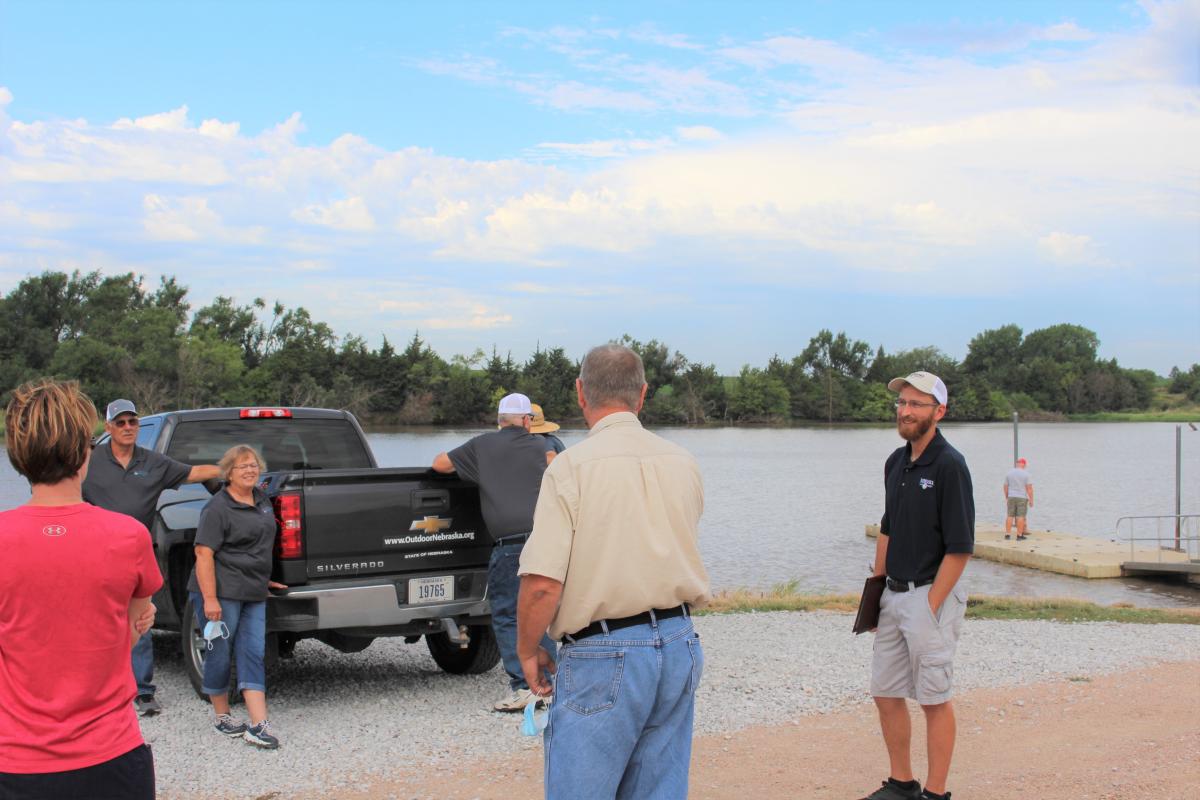
Perrion had some suggestions for the board members on how the fishery could be improved, including digging out the sediment dam on the north end of the lake and designing a wetland area with early successional vegetation to provide better filtration for water entering the lake. Perrion was enthusiastic about a recent board decision to provide incentive payments to producers whose fields drain into Recharge Lake (and other targeted areas) for additional conservation efforts to reduce erosion. Cover crops, buffer strips, and other land treatment practices would prevent sediment from entering waterbodies by holding soil in place on the fields. Perrion suggested that improving the lands around the lake is an important first step before additional funds are spent on restoring the lake.
 The next stop was Midwest Research Inc, a research farm a few miles from Recharge Lake. Owner Jess Spotanski demonstrated an agricultural drone that can be used to plant cover crops and buffer strips in places that are hard to reach by other methods. Spotanski flew the drone over a field of soybeans, spreading a cover crop mixture a few feet above the plants waving in the wind created by the drone’s eight powerful propellers. The drone can be programed to drop seed with a high degree of precision in a specific pattern or location. The day before the tour, Spotanski and his drone operator used the same piece of equipment to seed a grassed waterway project on a washed-out channel in a field near Recharge Lake. If this planting is successful, the NRD may employ this technology in other locations as it is a simple way to reduce erosion and protect surface water from contamination.
The next stop was Midwest Research Inc, a research farm a few miles from Recharge Lake. Owner Jess Spotanski demonstrated an agricultural drone that can be used to plant cover crops and buffer strips in places that are hard to reach by other methods. Spotanski flew the drone over a field of soybeans, spreading a cover crop mixture a few feet above the plants waving in the wind created by the drone’s eight powerful propellers. The drone can be programed to drop seed with a high degree of precision in a specific pattern or location. The day before the tour, Spotanski and his drone operator used the same piece of equipment to seed a grassed waterway project on a washed-out channel in a field near Recharge Lake. If this planting is successful, the NRD may employ this technology in other locations as it is a simple way to reduce erosion and protect surface water from contamination.
Midwest Research Inc owner Jess Spotanski demonstrates an agricultural drone that can be used to plant cover crops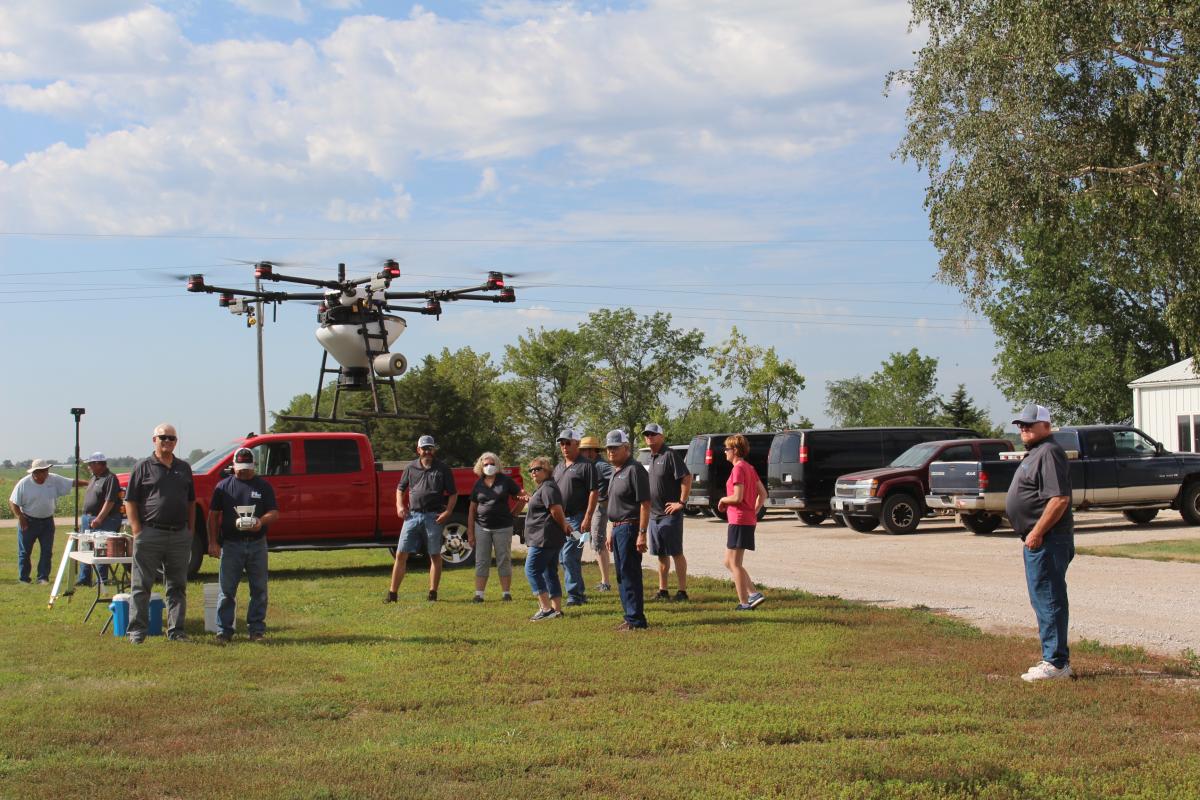
The tour continued with a visit to Pioneer Trails Recreation Area near Aurora. There, board members met with Brad Eifert, another fisheries biologist with Nebraska Game and Parks, who gave a report on the health of the fishery at that site. While not an ideal fishing spot due to increased sediment, the water quality in general is better for fish habitat than Recharge Lake. Eifert reiterated the need for conservation practices in the farmland surrounding the lake to improve water quality; however, the most recent fishing report from Pioneer Trails suggests that there are a decent number of largemouth bass and bluegill thriving in the reservoir, in addition to channel catfish and crappie.
While at Pioneer Trails Recreation Area, the board members also met with Nelson Winkel, a soil health specialist with The Nature Conservancy. Winkle gave a report on the interseeder cover crop trials that the Upper Big Blue NRD, The Nature Conservancy, and Nebraska Extension have partnered to conduct. The project began in 2020 and will continue through 2022. It includes planting a cover crop mix between rows of corn at the V4 to V6 stage of development at 11 test sites across the district. The interseeder planter was on display at the recreation area so that board members could see the equipment up close and talk to Winkle about how it is employed.
Nelson Winkle with The Nature Conservancy shows off the interseeder to board member Lynn Yates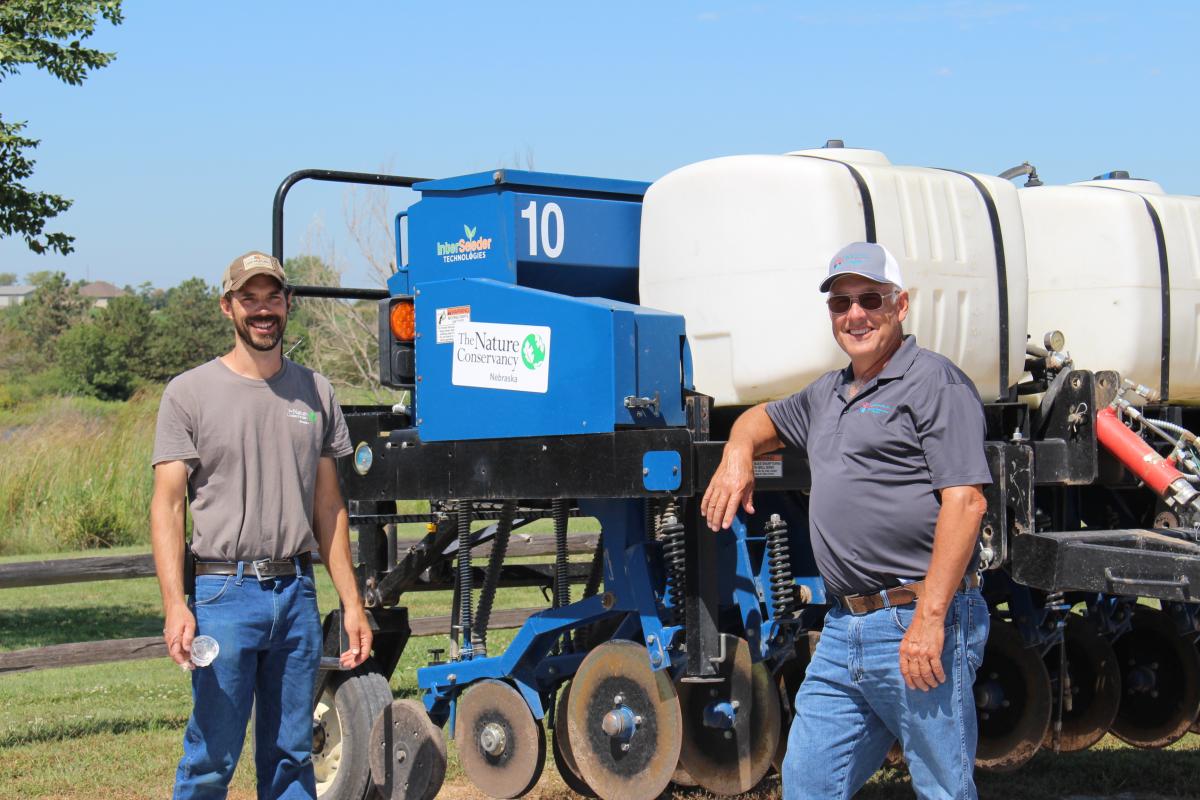
The tour continued with stops in Hampton, first at a monitoring well site south of town, where NRD staff demonstrated how wells are sampled. Water from monitoring wells across the district is sampled several times throughout the year to determine the amount of nitrogen and other contaminants present and to look at trends in water quality over time. The wells vary in depth, allowing for data collection from shallow, medium, and deep well sites to capture a more accurate picture of the health of the district’s groundwater. The Upper Big Blue NRD has been tracking this data consistently since 1997 to look at non-point source contamination in the groundwater supply.
The second Hampton stop was at the NRD’s newest recreation area site, Teal View Wetland Education Area. While the location is still largely undeveloped, the board was able to see the site and get a better understanding of how it will be improved in the coming months, including with infrastructure to graze cattle. Cattle will be used as a management tool to maintain the health of the wetland in the future. The location will be a great spot for hunting and other recreation, as well as a place for students to learn more about the importance of wetlands in Nebraska’s landscape.
Board members snip a ceremonial ribbon at Teal View Wetland Education Area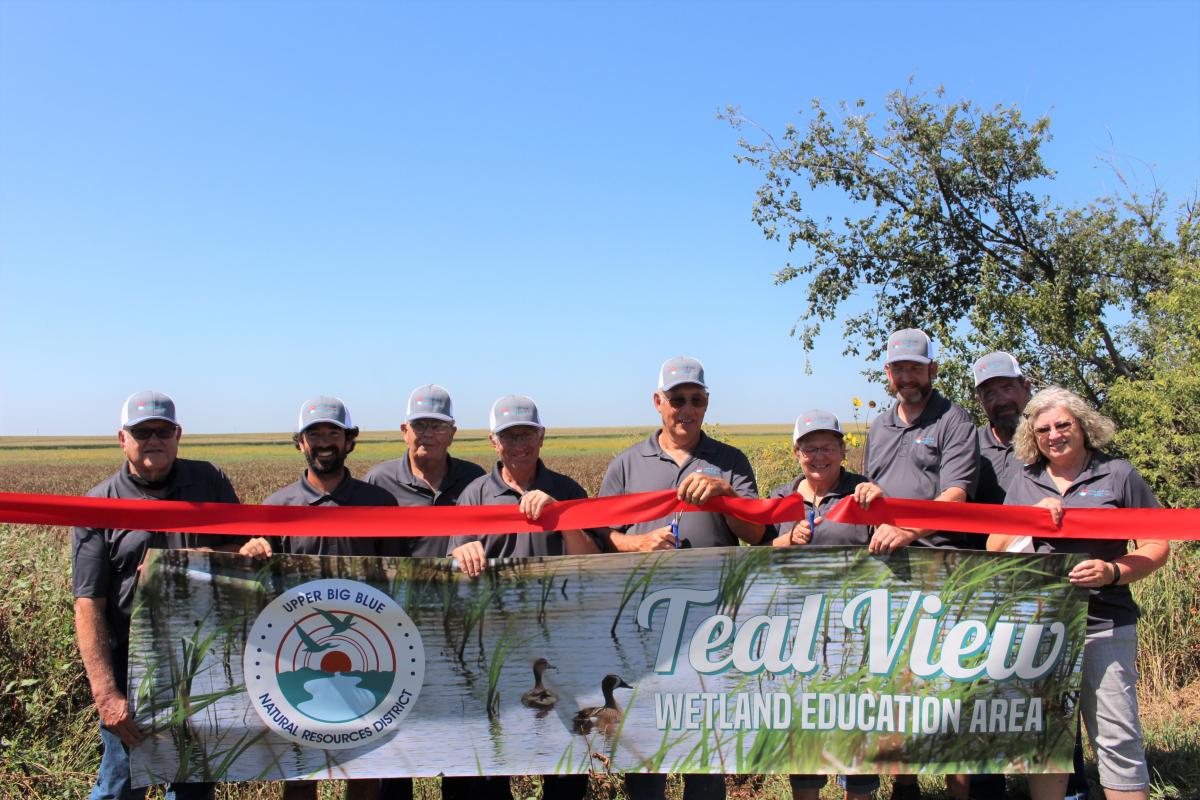
 The final destination on the tour was to the soil health demonstration fields managed by the Upper Big Blue NRD on the City of York’s wellfield. The board members heard a presentation from Dan Leininger, water conservationist with the NRD, who oversees Project GROW (Growing Rotational Crops on Wellfield). Now in the fourth year of the project, Leininger and cooperating producer Scott Gonnerman, are experimenting new crops, including alfalfa and milo. In addition to diverse crop rotations, Project GROW also enhances the soil health on these fields with livestock grazing, no-till, and cover crops. These practices increase the microbial activity of the soil as well as its water holding capacity, so that it can provide maximum fertility naturally, without a reliance on synthetic fertilizer and other inputs that would potentially contaminate the water in the wellfield. This wellfield provides drinking water for the more than 8,000 people who reside in York, so maintaining quality above this source is important for the health of York’s citizens. Project GROW is intended to be a program that could be reproduced at public wellfield sites across the district.
The final destination on the tour was to the soil health demonstration fields managed by the Upper Big Blue NRD on the City of York’s wellfield. The board members heard a presentation from Dan Leininger, water conservationist with the NRD, who oversees Project GROW (Growing Rotational Crops on Wellfield). Now in the fourth year of the project, Leininger and cooperating producer Scott Gonnerman, are experimenting new crops, including alfalfa and milo. In addition to diverse crop rotations, Project GROW also enhances the soil health on these fields with livestock grazing, no-till, and cover crops. These practices increase the microbial activity of the soil as well as its water holding capacity, so that it can provide maximum fertility naturally, without a reliance on synthetic fertilizer and other inputs that would potentially contaminate the water in the wellfield. This wellfield provides drinking water for the more than 8,000 people who reside in York, so maintaining quality above this source is important for the health of York’s citizens. Project GROW is intended to be a program that could be reproduced at public wellfield sites across the district. “It’s really important for directors to see the projects and programs in our district first-hand so we can make better decisions when these things come up for discussion,” said Lynn Yates, board chairperson, who attended the tour. “If you can see things yourself, it’s easier to understand. I wish all directors would go on these tours because there is so much to see in the district.” Yates appreciated the expert input provided by the fisheries biologists. “I learned so much from the two from Nebraska Game and Parks. It was helpful to learn more about water quality in our reservoirs and what we can do to improve it.”
“It’s really important for directors to see the projects and programs in our district first-hand so we can make better decisions when these things come up for discussion,” said Lynn Yates, board chairperson, who attended the tour. “If you can see things yourself, it’s easier to understand. I wish all directors would go on these tours because there is so much to see in the district.” Yates appreciated the expert input provided by the fisheries biologists. “I learned so much from the two from Nebraska Game and Parks. It was helpful to learn more about water quality in our reservoirs and what we can do to improve it.”
